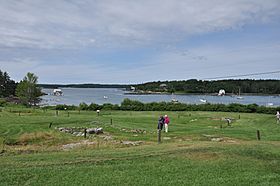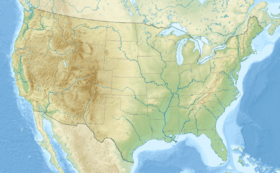Colonial Pemaquid State Historic Site facts for kids
|
Pemaquid Archeological Site
|
|

Foundation holes of the colonial settlement
|
|
| Location | Lincoln County, Maine, USA |
|---|---|
| Nearest city | Bristol, Maine |
| Area | 24 acres (9.7 ha) |
| Built | 1610 |
| NRHP reference No. | 69000022 |
Quick facts for kids Significant dates |
|
| Added to NRHP | December 2, 1969 |
| Designated NHLD | April 12, 1993 |
Colonial Pemaquid State Historic Site is a really interesting place in Bristol, Maine. It's run by the state of Maine and is near Pemaquid Beach. This site lets you explore history!
You can see a rebuilt Fort William Henry here. There are also old foundations from villages and forts from the 1600s and 1700s. A museum shows off cool items found at the site. These include old musket balls, coins, pottery, and tools.
Pemaquid was a very important spot long ago. It was often a place of conflict between English and French settlers. There were also struggles between English settlers and the local Native people. People have been interested in this historical site since the late 1800s. It became a state park in 1903. It was recognized as a special historical place in 1969 and then as a National Historic Landmark in 1993.
Contents
What is Colonial Pemaquid?
Colonial Pemaquid is located on a small piece of land. This land sticks out into the Pemaquid River in mid-coast Maine. The area is mostly flat or gently sloped and covered in grass. You can drive to the site and find parking areas above the main historical village.
There's a visitor center and a small museum built in the 1900s. An old house from the 1700s is now used by archaeologists. They use it as a lab and for storing artifacts. The rebuilt Fort William Henry stands at the very tip of the land.
Exploring the Old Village and Forts
The eastern part of the site was once a busy colonial village. Today, you can only see dips and bumps in the grass where buildings once stood. The western part of the site held Fort William Henry from the 1600s. Later, Fort Frederick was built there in the 1700s.
You can still see parts of the old building foundations. Experts say these old remains are very well preserved. Many items were buried deep enough to avoid damage when the land was farmed. Farming also helped fill in old cellar holes, keeping artifacts safe.
A Look Back: Pemaquid's History
Pemaquid has a long history of settlement, starting in the early 1600s. The area faced many conflicts. It was attacked several times and completely abandoned twice. English and French traders and fishermen used the area seasonally. The first permanent home was built in 1628.
The Pemaquid area was important because of its location. The French believed it was part of their territory called Acadia. Early English settlers traded with other English colonies and with the local Abenaki people. They also traded with the French.
Changes in Control and Early Conflicts
In 1664, King Charles II gave the area to his brother, James, Duke of York. It became part of the Province of New York. At that time, there were fewer than 30 houses. By 1673, the area was controlled by the Massachusetts Bay Colony. It had over 40 houses and 150-200 people.
A big war called King Philip's War happened in 1675. Pemaquid and nearby settlements were attacked. The community was abandoned in 1676. After the war, New York took control again. They set up a government and gave special trading rights to a few people. In 1688, the area became part of the Dominion of New England.
The governor, Edmund Andros, built a wooden fort in 1688. But this fort couldn't stop an attack. In 1689, during King William's War, French and Native forces attacked and destroyed the community.
Building and Losing Forts
The Dominion of New England fell apart in 1692. Massachusetts then built the strong stone Fort William Henry that same year. It cost a lot of money. But conflicts with Native people and the French continued. In 1696, a major attack happened. French forces, Native allies, and French ships captured and destroyed the settlement.
Pemaquid was not settled again until 1729. This was because Native resistance continued until the 1720s, ending with Dummer's War.
In 1729, a man named David Dunbar tried to start a colony of Irish settlers called "Georgia" at Pemaquid. He built Fort Frederick. But leaders in Massachusetts didn't like this idea. They asked the king to get control of the area back, and they succeeded.
Settlers stayed, but the area became less important for military reasons. This was especially true after New France was defeated in 1759 during the French and Indian War. During the American Revolutionary War, local leaders tore down Fort Frederick. They didn't want British troops to use it. Pemaquid then became a quiet, rural area.
Rediscovering Pemaquid's Past
People became interested in Pemaquid's history in the late 1800s. Early archaeological digs found the foundations of the old fort. The state bought the site in 1903. The large, round part of Fort William Henry was rebuilt in 1908. This was based on old drawings from 1699.
Archaeologist Warren K. Moorehead studied the site in the 1920s. But serious, organized archaeological work didn't start until the 1960s. This important work continues even today, helping us learn more about Pemaquid's past.
See also



